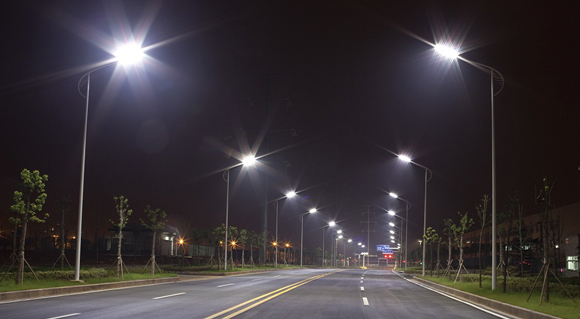I can see the enemy advancing by the day. The sidewalks that crisscross my neighborhood have mostly changed over to newfangled LED streetlights, while my block—a quiet residential side street—remains bathed in the orange glow of classic sodium-vapor lights. At least for now. Every night I find myself walking home under this reassuring glow, I know it could be the last. The writing is on the wall (and well-publicized city plans): Even forgotten holdout blocks will eventually fall to the LED’s promise of cheap, energy-efficient, and ever-so-bright white light.
Now, you may know this change is fraught with issues. LED streetlights are decidedly less romantic, add to light pollution, totally mess with our circadian rhythms, and are flat-out ugly. What you may not know: This transition is all the more tragic because almost all of these drawbacks could be avoided.
First, a quick primer on the science of the issue: Aesthetics aside, the pale white light emitted by LED streetlights effectively tricks our brains into thinking it is daytime, and that we should be awake and alert. Our eyes have three types of light receptors: The rods and cones that we all know of, and their lesser-known cousin called photosensitive Retinal Ganglion Cells. While rods and cones let us see, these other cells—which weren’t even discovered until the 1990s—act as a sort of internal sunlight detector. When they detect daytime, they tell our brains to suppress the release of the sleep-inducing hormone melatonin, effectively making it much harder to catch Zs.
Now, the problem comes from how these cells detect daylight: They are uniquely sensitive to the short wavelengths present in white and blue lights. A red-lit darkroom? Great place to catch a nap. The white and blue light of most LED streetlights (as well as our gadget screens)? Huge problem. Especially in comparison to the long-wavelength orange glow of the old lamps, which did far less to scream “daytime!” to our brains.
The tragedy: LEDs don’t have to be this bad. LED lights are incredibly versatile pieces of technology. Anybody who has ever seen a Philips Hue setup knows that they are almost infinitely adjustable. Unlike incandescents, LEDs are digital devices that can be programmed to shift color or brightness on schedule, on demand, or when certain parameters are met. I actually use Hue LEDs to bathe my bedroom in red at night in an attempt to counter many of the problems that these new streetlights are introducing (or at least exacerbating) into the cityscape.
The problem with the current rollout of LED lights is that it seems to be executed without any regard for these issues or their possible solutions. Instead of indiscriminately blasting white light, it would be possible—and in fact, not terribly difficult—to create programmable LED systems that at least partially filter out offending wavelengths at certain hours. I am sure there are plenty of researchers in this space who would jump at the opportunity to help out. Now, basking our streets in a creepy red glow may not feel as safe as a pore-revealing white blast, but these folks would surely be able to settle on a solution that offers the safety of a well-lit street in a way that doesn’t absolutely ruin our sleep and overall health.
And this is a major public health issue. These streetlights are built to last a long time, and every block that gets switched over without concern for the health consequences could subject a generation of city-dwellers to health issues that we are only now beginning to understand. An ever-growing body of research suggests that ambient exposure to blue and white light prior to and during sleep can lead to a huge array of problems that go far beyond fatigue. Even if you can fall asleep with this light peeking through your window, your sleep quality—and health—could still suffer in ways that may not be known for years, when our citizens begin to exhibit rising rates of just about everything.
Follow me on Twitter at @sethporges.




